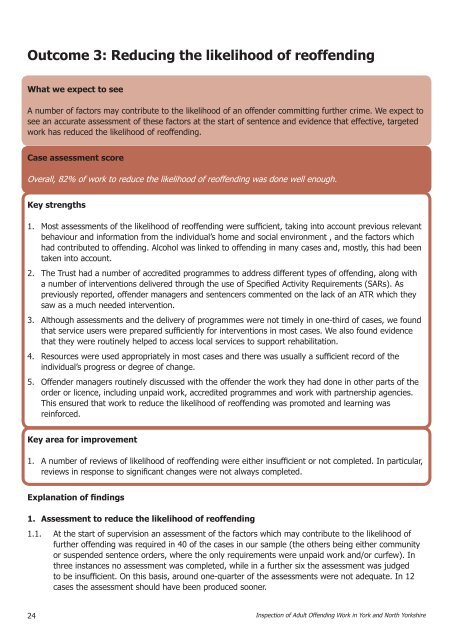york-north-yorkshire-iaow
york-north-yorkshire-iaow
york-north-yorkshire-iaow
Create successful ePaper yourself
Turn your PDF publications into a flip-book with our unique Google optimized e-Paper software.
Outcome 3: Reducing the likelihood of reoffendingWhat we expect to seeA number of factors may contribute to the likelihood of an offender committing further crime. We expect tosee an accurate assessment of these factors at the start of sentence and evidence that effective, targetedwork has reduced the likelihood of reoffending.Case assessment scoreOverall, 82% of work to reduce the likelihood of reoffending was done well enough.Key strengths1. Most assessments of the likelihood of reoffending were sufficient, taking into account previous relevantbehaviour and information from the individual’s home and social environment , and the factors whichhad contributed to offending. Alcohol was linked to offending in many cases and, mostly, this had beentaken into account.2. The Trust had a number of accredited programmes to address different types of offending, along witha number of interventions delivered through the use of Specified Activity Requirements (SARs). Aspreviously reported, offender managers and sentencers commented on the lack of an ATR which theysaw as a much needed intervention.3. Although assessments and the delivery of programmes were not timely in one-third of cases, we foundthat service users were prepared sufficiently for interventions in most cases. We also found evidencethat they were routinely helped to access local services to support rehabilitation.4. Resources were used appropriately in most cases and there was usually a sufficient record of theindividual’s progress or degree of change.5. Offender managers routinely discussed with the offender the work they had done in other parts of theorder or licence, including unpaid work, accredited programmes and work with partnership agencies.This ensured that work to reduce the likelihood of reoffending was promoted and learning wasreinforced.Key area for improvement1. A number of reviews of likelihood of reoffending were either insufficient or not completed. In particular,reviews in response to significant changes were not always completed.Explanation of findings1. Assessment to reduce the likelihood of reoffending1.1. At the start of supervision an assessment of the factors which may contribute to the likelihood offurther offending was required in 40 of the cases in our sample (the others being either communityor suspended sentence orders, where the only requirements were unpaid work and/or curfew). Inthree instances no assessment was completed, while in a further six the assessment was judgedto be insufficient. On this basis, around one-quarter of the assessments were not adequate. In 12cases the assessment should have been produced sooner.24 Inspection of Adult Offending Work in York and North Yorkshire


